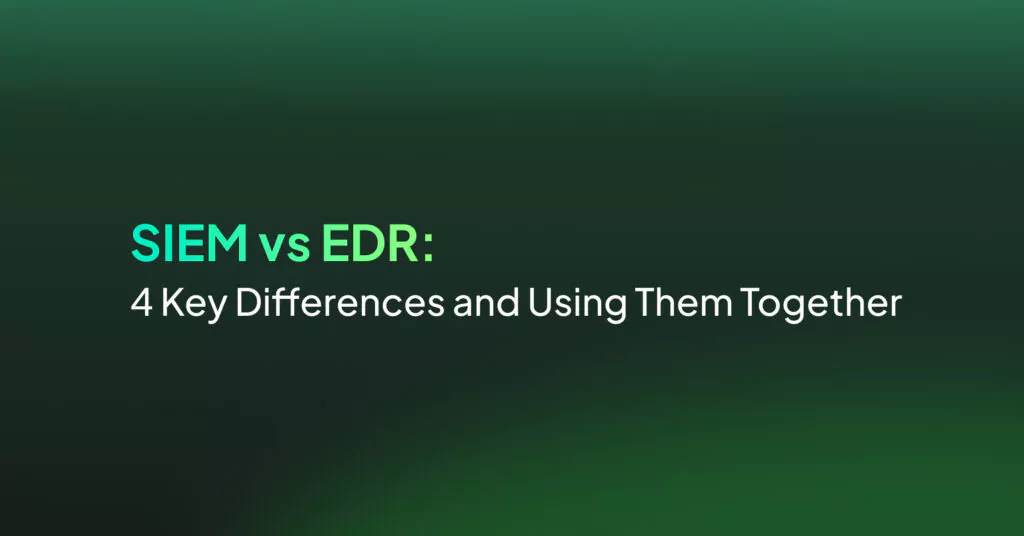SIEM vs MDR: 5 Key Differences & Using Them Together

How SIEM Works
SIEM systems offer the following capabilities.
Data Collection and Aggregation
SIEM systems gather data from diverse IT assets like servers, network devices, and applications. The effectiveness of a SIEM largely hinges on the scope and granularity of the logs ingested. Once collected, these logs are centrally aggregated, which simplifies monitoring by providing a single point of reference for security data.
Aggregation enables the SIEM to correlate data across different sources, improving visibility into multi-faceted threats. By organizing data, SIEM tools can rapidly detect anomalies and potential threats across entire networks, providing insights into security events that are spread over diverse infrastructure components.
Log Management and Analysis
Log management in SIEM involves the storage, analysis, and retrieval of log data. These logs are processed to normalize data, ensuring consistency in format and supporting accurate analysis. This normalized data is then stored for real-time alerting and historical analysis essential for security audits and compliance verification.
The analysis component of SIEM relies on algorithms to identify patterns and anomalies in the log data. This aids in current threat detection and allows for in-depth forensic analysis of past security incidents. By maintaining structured logs, SIEM improves an organization’s ability to trace malicious activities accurately.
Event Correlation and Alerting
SIEM systems correlate events by linking diverse log entries to identify potentially related incidents. Through correlation rules, SIEM can connect seemingly unrelated events to detect complex attack vectors or sequential threats. This capability is crucial in identifying advanced persistent threats that evade simpler detection mechanisms.
Once correlations are established, SIEM platforms generate alerts that prioritize response efforts. These alerts are configured based on predefined thresholds and rules, ensuring that critical threats are emphasized over false alarms. Effective SIEM implementations tailor alert settings to fit organizational needs, ensuring rapid and informed incident response.
How MDR Works
MDR services typically offer the following capabilities.
Continuous Threat Monitoring
MDR services provide ongoing monitoring of an organization’s IT environment, identifying new and emerging threats in real time. This involves using detection technologies alongside expert threat analysts who assess and address any potential incidents. The continuous nature of MDR surveillance ensures that threats are detected promptly.
Unlike static systems, MDR adapts to emerging threats by updating detection methods and leveraging intelligence from previous incidents. This adaptive model allows MDR providers to anticipate and counteract evolving attack strategies, providing organizations with a dynamic defense mechanism against cyber threats.
Managed Detection Services
Managed detection services include threat identification technologies combined with expert analytical insights. This service layer involves actively looking for threats that might evade standard detection methods, employing techniques such as behavioral analysis and threat hunting. This proactive stance aids in addressing threats before they lead to data breaches.
MDR providers deploy a range of detection tools, from endpoint monitoring to network analysis, ensuring coverage. By addressing multiple threat vectors and leveraging cutting-edge tools, MDR enhances an organization’s ability to detect hidden and advanced threats.
Incident Response and Remediation
In the event of a breach, MDR enables rapid incident response and containment activities. Response protocols are often collaboratively developed with clients, ensuring actions align with organizational policies. With MDR, security experts take lead roles in isolating threats, deploying countermeasures, and guiding recovery processes.
Remediation in MDR involves thorough analysis and removal of threats from the IT environment. By ensuring comprehensive threat neutralization, MDR curtails immediate impacts and aids in preventing recurrence.
Key Differences Between SIEM and MDR
Here’s an overview of how these two security solutions compare in several key areas.
1. Core Functions and Capabilities
SIEM focuses primarily on data collection, aggregation, and analysis. Its primary purpose is to provide centralized visibility into security events by ingesting logs and correlating data from multiple sources. SIEM systems excel in event correlation, compliance reporting, and forensic analysis, but their effectiveness relies heavily on how well they are configured and managed.
MDR provides an end-to-end managed service that includes real-time threat monitoring, detection, and incident response. MDR services combine detection tools with expert-driven threat analysis, offering a more proactive approach to identifying and mitigating risks. Unlike SIEM, MDR emphasizes immediate action against threats rather than just offering visibility and analysis.
2. Deployment and Management
SIEM tools require significant effort for deployment and management. Organizations need to establish log collection points, configure correlation rules, and ensure proper tuning to minimize false positives. Maintaining a SIEM system often demands a dedicated team with expertise in log analysis and system configuration.
MDR services are typically delivered by external providers and require minimal in-house setup. MDR providers manage the entire lifecycle of threat detection and response, from deployment to continuous monitoring. This outsourcing model reduces the management burden on internal IT teams, making MDR particularly attractive for organizations with limited security resources.
3. Human Expertise Involvement
SIEM systems rely on internal teams for monitoring and interpreting alerts. This means that an organization’s security analysts must have the expertise to identify, prioritize, and respond to potential threats flagged by the SIEM. Without skilled personnel, SIEM implementations can become ineffective due to misconfigurations or unaddressed alerts.
MDR integrates human expertise directly into the service offering. Experienced analysts monitor environments, investigate anomalies, and respond to incidents in real time. This human-driven approach ensures that even subtle or sophisticated threats are identified and mitigated promptly. MDR bridges the skills gap for organizations without in-house cybersecurity expertise.
4. Response Time and Effectiveness
SIEM systems provide detailed alerts and log-based insights, but they require manual intervention to act on the information. As a result, response times depend on the availability and efficiency of the internal security team. In some cases, delays in addressing alerts can lead to extended threat exposure.
MDR services are designed for immediate action. With a team of experts constantly monitoring systems, threats are identified and neutralized swiftly. MDR’s proactive incident response ensures that threats are not only detected but also contained and resolved in a timely manner, significantly reducing the potential impact of attacks.
5. Cost and Resource Allocation
SIEM system implementation and maintenance involves substantial costs, including licensing fees, infrastructure investments, and personnel expenses. Organizations also need to allocate resources for ongoing tuning and upgrades to keep the SIEM effective against evolving threats.
MDR services operate on a subscription model, which offers predictable costs and scalability. This approach eliminates the need for heavy upfront investments in tools and personnel. For organizations with constrained budgets, MDR provides access to enterprise-grade security capabilities without the financial and operational burden of managing the system in-house.
Integrating SIEM and MDR for Enhanced Security
Combining SIEM and MDR can provide a stronger security strategy by leveraging the advantages of both approaches:
- Augmented threat detection and visibility: Integrating SIEM with MDR enhances threat detection by combining the data aggregation and correlation capabilities of SIEM with the monitoring and expertise of MDR. SIEM collects extensive logs and identifies patterns, while MDR provides human oversight to interpret complex scenarios and detect threats that may not be evident through automated analysis alone.
- Improved incident response efficiency: MDR’s real-time response capabilities complement SIEM’s alerting functions by enabling immediate action on detected threats. While SIEM identifies and logs suspicious activities, MDR teams can actively investigate and remediate incidents. This reduces response times, ensuring that threats are contained and neutralized before causing significant damage.
- Scalability and resource optimization: Organizations can leverage SIEM for centralized data management and regulatory compliance, while MDR services handle the operational aspects of threat monitoring and response. This reduces the need for in-house resources dedicated to managing and interpreting SIEM alerts, allowing internal teams to focus on other priorities.
- Actionable insights and forensic capabilities: By integrating SIEM’s historical data analysis with MDR’s expertise, organizations gain actionable insights into both current and past incidents. SIEM logs provide a detailed trail for forensic investigations, while MDR specialists help contextualize these logs to uncover root causes and inform future security measures.
- Customization and flexibility: An integrated SIEM-MDR solution can be tailored to align with an organization’s needs. SIEM provides the backbone for data ingestion and compliance, while MDR services customize threat detection and response protocols based on the organization’s risk profile.
Cloud SIEM with Coralogix
Coralogix sets itself apart in observability with its modern architecture, enabling real-time insights into logs, metrics, and traces with built-in cost optimization. Coralogix’s straightforward pricing covers all its platform offerings including APM, RUM, SIEM, infrastructure monitoring and much more. With unparalleled support that features less than 1 minute response times and 1 hour resolution times, Coralogix is a leading choice for thousands of organizations across the globe.





